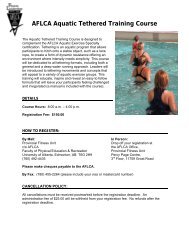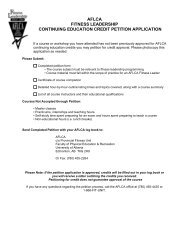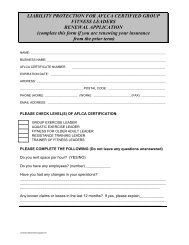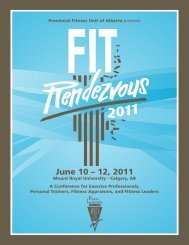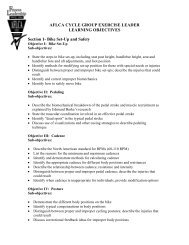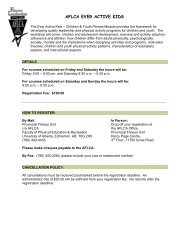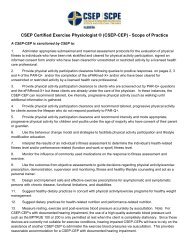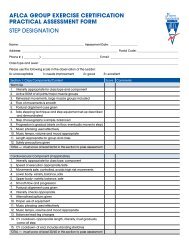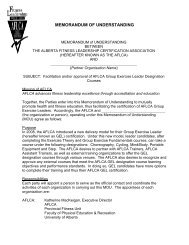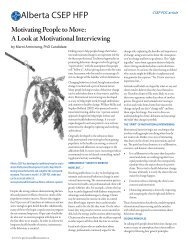AFLCA PORTABLE EQUIPMENT GROUP EXERCISE LEADER ...
AFLCA PORTABLE EQUIPMENT GROUP EXERCISE LEADER ...
AFLCA PORTABLE EQUIPMENT GROUP EXERCISE LEADER ...
You also want an ePaper? Increase the reach of your titles
YUMPU automatically turns print PDFs into web optimized ePapers that Google loves.
<strong>AFLCA</strong> <strong>PORTABLE</strong> <strong>EQUIPMENT</strong> <strong>GROUP</strong> <strong>EXERCISE</strong> <strong>LEADER</strong><br />
LEARNING OBJECTIVES<br />
Section 1- Use of Portable Equipment<br />
Objective I: The evolution of portable equipment<br />
Sub-objectives:<br />
• Describe the evolution of the following pieces of equipment: free weights, body bars/<br />
barbells, stability balls, tubing/resist-a-bands, BOSUs, steps, medicine balls, foam<br />
rollers (may include others)<br />
• State the benefits of using each piece of equipment<br />
• Describe the purpose of each piece of equipment- i.e. used in what component, into<br />
what type of classes can it be incorporated, types of classes that can be created?<br />
Objective II: Research and safety guidelines<br />
Sub-objectives:<br />
• Describe and apply research principles as they apply to safe technique, repetitions,<br />
posture and alignment<br />
• Describe proper equipment maintenance for each<br />
• Describe and demonstrate proper technique<br />
• Demonstrate and distinguish between proper and improper technique and posture;<br />
describe the injuries that could result<br />
• Identify contraindicated and ineffective exercises<br />
• Describe legal risks of using equipment<br />
Section 2- Class Structure and Content<br />
Objective I: Planning for and implementing the components of a portable<br />
equipment class<br />
Sub-objectives:<br />
• Identify components of an equipment-based group exercise class and what to include<br />
in each component<br />
• Describe safety guidelines to consider when designing each component<br />
• Describe methods for evaluating and monitoring intensity<br />
• Discuss how the components may be varied for different populations<br />
Objective II: Use of music in a portable equipment class<br />
Sub-objectives:<br />
• Select music of appropriate tempo and volume for each component<br />
• Demonstrate 8 and 32 count awareness
• Describe the uses and effectiveness (or ineffectiveness) of designing exercise patterns<br />
based on 32 counts<br />
Section 3- Leadership and Choreography Design<br />
Objective I: Equipment Exercises<br />
Sub-objectives:<br />
• List exercises and variations possible for each piece of equipment<br />
Objective II: Movement combinations/choreography design<br />
Sub-objectives:<br />
• Prepare effective lesson plans<br />
• Evaluate lesson plans using established methods and training principles<br />
• Demonstrate the basic principles of movement (choreography) design to develop<br />
routines considering factors such as music, tempo, phrasing, rhythm, space, directions,<br />
plane and lever variations, transitions (including picking up and putting away<br />
equipment) , pattern breakdown, flow, variety, balance and safety<br />
• Demonstrate various instructional techniques: progression from simple to complex,<br />
pattern development techniques, variety of class formations, use of verbal and nonverbal<br />
cueing<br />
• Demonstrate understanding of proper use of equipment<br />
• Recommend appropriate equipment selection based on participants needs and levels<br />
• Demonstrate appropriate class design based on principles of conditioning, FITT<br />
formula, anatomy, biomechanics and selection<br />
Objective III: Instruction, cueing and leadership<br />
Sub-objectives:<br />
• Discuss instructional techniques that improve cueing effectiveness (mirror imaging,<br />
timing of cues, consistency and conciseness)<br />
• Utilize common exercise terms<br />
• Describe ways to identify with audience and connect with participants<br />
• Describe how to observe, respond and adapt to participant needs<br />
• Demonstrate good verbal and visual cueing skills with emphasis on technique<br />
• Describe how to set an enthusiastic, motivational environment<br />
• List the instructional challenges specific to portable equipment-based group exercise<br />
classes



